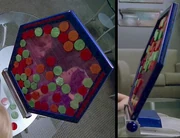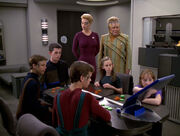
A kadis-kot board
A player putting a piece on the board
Kadis-kot was a board game played with two or more players. It consisted of three sets of colored pieces, red, green, and orange, which needed to be placed on a hexagonal board. Every set was made up of round and hexagonal pieces of each color, although it is not clear if the differently-shaped pieces moved differently during game play. The board itself was divided into grids, and each grid had its own coordinate, such as grid 14-4 or 1-16. Although players chose the color they wanted to use in game play, it appears that all three colors could be moved by any player during the game. (VOY: "Endgame")
Game play
In a game all three colors were used. Pieces could be added or moved around on the board. A move was made by calling the color and position the piece needed to be placed, such as "red, grid 13-3" or "11-6, Green". A counter-move could be made by calling "counter" and placing, or moving around, a piece on the board.
A win was declared by calling "kadis-kot". In one-on-one games, the player with the most wins would win the overall competition.
USS Voyager crewmembers also played kadis-kot via a subspace communication channel. Each player had a board on which the pieces were placed. Every player moved both his own and his opponents' pieces to follow the progress of the game.
The total number of pieces needed to play this game is unknown. However, at a given time there were at least eleven orange, twenty-four red, and twenty-three green pieces in a game, although not all on the board at the same time. The maximum numbers of players seen participating in a kadis-kot game was five. (VOY: "Ashes to Ashes")
Players
Kadis-kot was played quite often aboard the Federation starship USS Voyager, particularly by Seven of Nine, Naomi Wildman, and Neelix. It was Seven's favorite game and green was her favorite playing color. (VOY: "Imperfection")
Seven and Naomi, who loved to play kadis-kot, played the game on a weekly basis while on Voyager. There were even kadis-kot tournaments organized. Naomi feared not being able to play the game with Seven once Voyager reached Earth. (VOY: "The Voyager Conspiracy") Naomi also played the game with her mother, Samantha. (VOY: "Infinite Regress")
Neelix played kadis-kot with Naomi on a regular basis; he even tried to play the game with Q's son. However, because it contained no explosions, Q's son was not interested in playing it. (VOY: "Q2") In 2378, after Neelix had left Voyager to live with an asteroid colony of Talaxians, he occasionally played kadis-kot over subspace with Seven. He told her that he was considering marrying Dexa while they were playing a game, but it was cut short when an unusual signature appeared on sensors, and they had to reschedule their game. (VOY: "Endgame")
Games played

Naomi and the Borg children playing
- Naomi versus Seven of Nine. Stardate 52356.2, 2375, Naomi's quarters. Seven won. (Technically it was not Seven who played the game but someone who surfaced from her time in the hive mind because of a malfunctioning vinculum nearby. After this, Naomi taught Seven how to play kadis-kot.) (VOY: "Infinite Regress")
- Naomi versus Seven of Nine. In 2376 they played in Voyager's mess hall. Outcome unknown.
- Naomi, Icheb, Mezoti, Azan, and Rebi, supervised by Seven of Nine. Stardate 53679.4, 2376, Voyager's mess hall. The game ended in disarray when Rebi and Azan were found cheating via their neural interface. After Seven told them to exercise Punishment Protocol 9-Alpha, Icheb swept some pieces off the table complaining that if they were not allowed to play, he would not play either. (VOY: "Ashes to Ashes")
- Neelix versus Seven of Nine. Stardate 54129.4, 2377, in sickbay. Seven won sixteen games out of eighteen with green. (VOY: "Imperfection")
- Neelix versus Joleg. Stardate 54474.6, 2377, in cargo bay one. Joleg, a Benkaran convict, won with green. His last move was "11-6, Green". (VOY: "Repentance")
- Naomi versus Brax. Stardate 54868.6, 2378, Voyager's mess hall. Naomi played with green. The game was broken off when Brax needed to go home. (VOY: "Homestead")
- Seven of Nine versus Neelix. Stardate 54973.4, 2378 via subspace. The last known move was "orange, grid 10-12", made by Neelix. The game was broken off when Seven detected neutrino emissions. They had agreed to continue this game, but the subsequent return of Voyager to the Alpha Quadrant may have prevented this. It is unknown if they ever played a kadis-kot game again. (VOY: "Endgame")
Appearances
- VOY:
- "Infinite Regress"
- "Ashes to Ashes"
- "Imperfection"
- "Repentance"
- "Homestead"
- "Endgame"
References
- VOY:
- "Bliss"
- "The Voyager Conspiracy"
- "Inside Man"
- "Q2"
Background
In "Infinite Regress" this game is mentioned by an assimilated child whose personality surfaces when Seven of Nine's cognitive functions are compromised due to a malfunctioning Borg vinculum. Images of this child shown in the episode portray her with Human features. Later in this episode, an assimilated child's personality, named "Maryl," identifies Tuvok as a Vulcan, providing an additional basis for identifying this personality as an Alpha Quadrant native. As it is assumed that these two appearances may represent the same child's personality, this would suggest that kadis-kot originated somewhere in the Alpha Quadrant. Naomi Wildman's familiarity with the game further suggests that kadis-kot originated as an Alpha Quadrant game and was probably developed by a Federation member world.
In "Repentance", Voyager meets the Benkarans for the first time. Neelix plays kadis-kot with Joleg, a Benkaran convict, who wins the game. Because this is the first time Voyager meets the Benkarans, one can assume that Joleg already knew how to play kadis-kot. There is no evidence that Neelix explained the game to him. This would suggest the game originated in the Delta Quadrant. It seems very strange that a game would have its origins in two quadrants, light years apart. Because the origin of kadis-kot was never mentioned on screen, one could surmise that the production team never thought much about the history of the game itself and simply introduced it.
